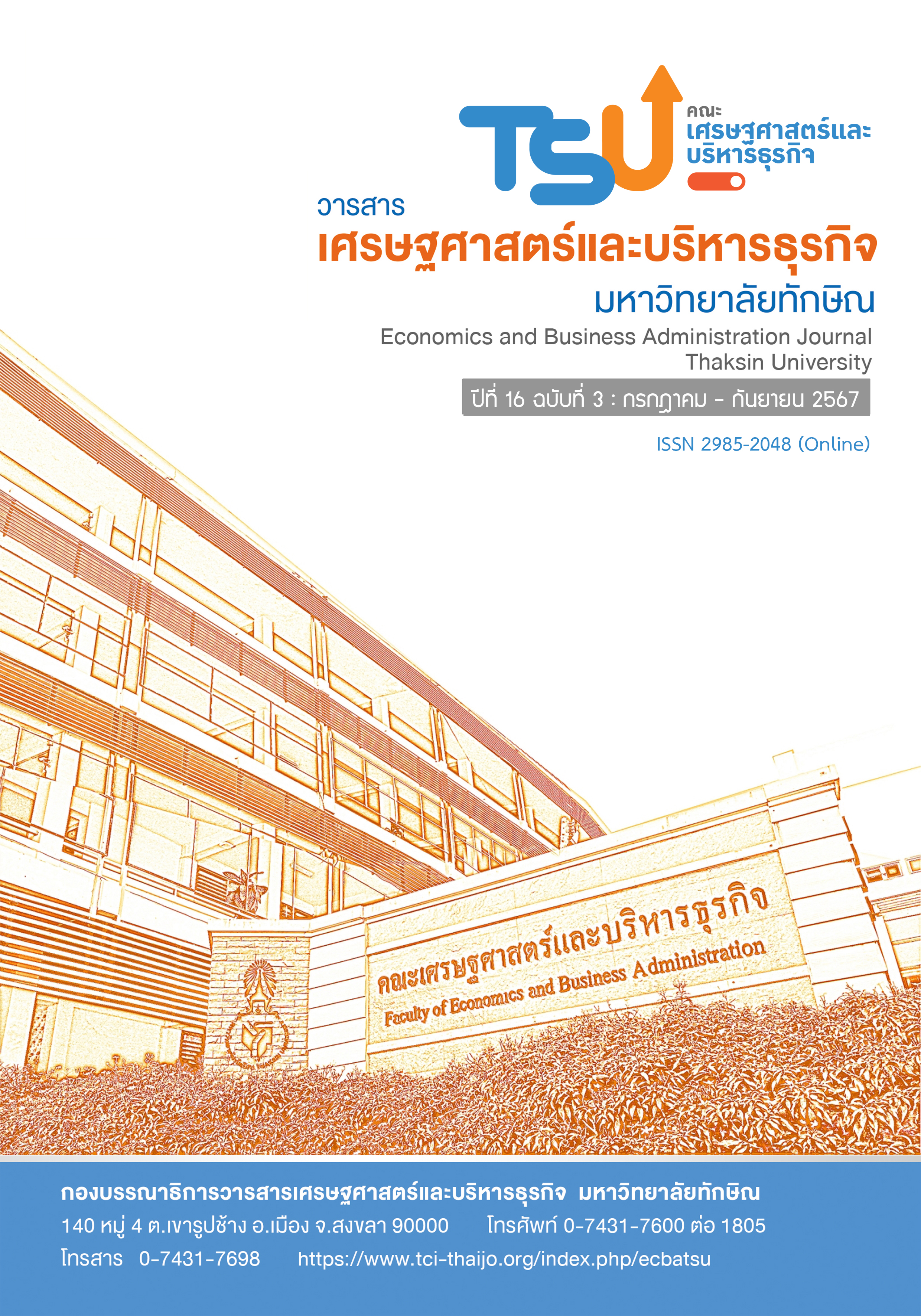Attitude of Donor through Utility Token for Public Hospital
DOI:
https://doi.org/10.55164/ecbajournal.v16i3.266583Keywords:
Incentive Factor, Donation, Utility Token, Public HospitalAbstract
This study aims to investigate the relationship between service users’ attitudes towards donating to public hospitals and the proposal of hospital services through Utility Tokens to donors. The purpose is to increase fundraising efforts and address the issue of budgetary constraints faced by public hospitals. This study used a survey research method combined with a qualitative approach. The sample group consisted of 400 Thai citizens who have used large government hospitals (more than 250 beds) in Bangkok. A questionnaire was used as a tool to collect data. The data were analyzed using statistical methods, including frequency, percentage, mean, standard deviation, t-test and Chi-square tests. Statistical significance was set at a level of 0.05. The results of this study revealed the majority of the sample group had donated to hospitals before. The most common attitude towards donating to hospitals was a charitable one. The most desired thing that the sample group wanted hospitals to provide for donors were direct appointment care services. However, when offered with the option of a Utility Token for donors, the sample group showed a significant trend towards donating more to public hospitals. Those who had donated to hospitals before were more likely to donate more frequently, while those who had never donated to hospitals before showed a tendency to change their minds and donate to hospitals. This study found that both users who had donated and those who had not donated to public hospitals were aware of the funding shortage and believed that public hospitals should receive more funding to improve their services. Offering service rights through Utility Tokens can positively influence the attitude of service users towards donating money to public hospitals.
References
Act on the Administration of State Affairs. (1991). Legal Database. Retrieve 10 April 2023, from http://regu.tu.ac.th/quesdata/Data/A81.pdf
Atkinson, R. (1989). Altruism in Nonprofit Organizations. BCL Rev., 31, 501.
Andreoni, J. (1990). Impure Altruism and Donations to Public Goods: A Theory of Warm-Glow Giving. The Economic Journal, 100(401), 464–477.
Arslanian, H. (2022). Utility Tokens and Social Tokens. In the Book of Crypto: The Complete Guide to Understanding Bitcoin, Cryptocurrencies and Digital Assets. Cham: Springer International Publishing.
Bamrungchit, S., & Panthanuwong A. (2021). Donors’ Media Exposure, Opinion towards Communication and Intention to Donate to Siriraj Foundation in COVID-19 Pandemic. Media and Communication Inquiry, 3(3), 1-11.
Bekkers, R., & Wiepking, P. (2011). Who Gives? A literature Review of Predictors of Charitable giving Part One: Religion, Education, Age and Socialisation.
Campino, J., Brochado, A., & Rosa, Á. (2022). Initial Coin Offerings (ICOs): Why do They Succeed?. Financial Innovation, 8(1), 17.
Chell, K., Davison, T. E., Masser, B., & Jensen, K. (2018). A Systematic Review of Incentives in Blood Donation. Transfusion, 58(1), 242-254.
Drasch, B. J., Fridgen, G., Manner-Romberg, T., Nolting, F. M., & Radszuwill, S. (2020). The Token’s Secret: The Two-faced Financial Incentive of the Token Economy. Electronic Markets, 30, 557-567.
Farrow, K., Grolleau, G., & Ibanez, L. (2017). Social Norms and Pro-environmental Behavior: A Review of the Evidence. Ecological Economics, 140, 1-13.
Glazer, A., & Konrad, K. A. (1996). A signaling explanation for charity. The American Economic Review, 86(4), 1019-1028.
Goette, L., & Stutzer, A. (2019). Blood Donations and Incentives: Evidence from a Field Experiment. Journal of Economic Behavior & Organization, 170, 52-74. DOI: https://doi.org/10.1016/j.jebo.2019.11.021
Graça, S. S. (2022). Increasing Donor’s Perceived Value from Charitable Involvement: A Multi-segment Approach to the American Donor Market. International Review on Public and Nonprofit Marketing, 1-24. DOI: https://doi.org/10.1007/s12208-022-00355-1
Hartmann, F., Grottolo, G., Wang, X., & Lunesu, M. I. (2019). Alternative Fundraising: Success Factors for Blockchain-based vs. Conventional Crowdfunding. In 2019 IEEE International Workshop on Blockchain Oriented Software Engineering (IWBOSE). IEEE.
Hong, J., & Loke, A. Y. (2011). Hong Kong Young People’s Blood Donation Behavior. Asian Journal of Transfusion Science, 5(1), 49.
Howden-Chapman, P., Carter, J., & Woods, N. (1996). Blood Money: Blood Donors' Attitudes to Changes in the New Zealand Blood Transfusion Service. BMJ, 312(7039), 1131-1132.
Jonathan, L. E. V. Y. (2016). Altruism and the Origins of Nonprofit Philanthropy. Philanthropy in Democratic Societies: History, Institutions, Values, 19.
Lacetera, N., & Macis, M. (2010). Do All Material Incentives for Pro-social Activities Backfire? The Response to Cash and Non-cash Incentives for Blood Donations. Journal of Economic Psychology, 31(4), 738-748.
Lambert, T., Liebau, D., & Roosenboom, P. (2021). Security Token Offerings. Small Business Economics, 59, 299–325.
Louis, W. R., Thomas, E., Chapman, C. M., Achia, T., Wibisono, S., Mirnajafi, Z., & Droogendyk, L. (2019). Emerging Research on Intergroup Prosociality: Group Members' Charitable Giving, Positive Contact, Allyship, and Solidarity with Others. Social and Personality Psychology Compass, 13(3), e12436.
National Health Security Act. (2002). Legal Database. Retrieve 10 April 2023, from http://nih.dmsc.moph.go.th/law/pdf/031.pdf
Ni, T., Wang, X., Wang, Y., & Li, M. (2022) Can the Deferred Donation Deduction Policy Promote Corporate Charitable Donations? Empirical Evidence from China, Emerging Markets Finance and Trade, 58(8), 2203-17.
Suppasilp, C. (2015). Factors Affecting Donations to Siriraj Foundation. Research Report, Thammasat University. Retrieve 10 April 2023, from http://ethesisarchive.library.tu.ac.th/thesis/2016/TU_2016_5804010402_6590_4715.pdf
Vesterlund, L. (2006). Why do people give. The nonprofit sector: A research handbook, 2, 168-190.
Wang, M., Cai, M., Guo, S., Li, M., Tan, X., Ou, C., & Lu, X. (2023). Large-Scale Medical Crowdfunding Data Reveal Determinants and Preferences of Donation Behaviors. IEEE Transactions on Computational Social Systems.
Whitehead, M., & Dahlgren, G. (1991). What Can be Done About Inequalities in Health?. The Lancet, 338(8774), 1059-1063.
Yamane, T. (1973). Statistics: an introductory analysis-3.
Ye, N., Teng, L., Yu, Y., & Wang, Y. (2015). “What’s in it for me?”: The Effect of Donation Outcomes on Donation Behavior. Journal of Business Research, 68(3), 480–486.
Downloads
Published
How to Cite
Issue
Section
License
Copyright (c) 2024 Faculty of Economics and Business Administration, Thaksin University

This work is licensed under a Creative Commons Attribution-NonCommercial-NoDerivatives 4.0 International License.




